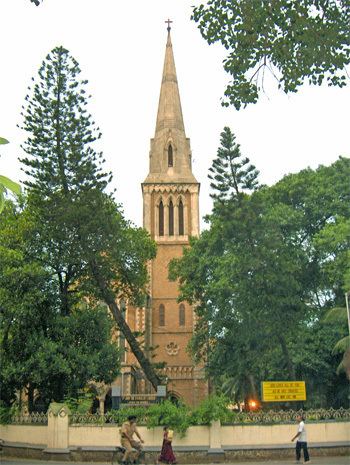Name Henry Conybeare Role Civil engineer | Died 1884 Parents William Conybeare | |
 | ||
Structures | ||
Henry Conybeare (22 February 1823 – 23 January 1892) was an English civil engineer and Gothic revival architect who designed two notable churches and greatly improved the supply of drinking water to Mumbai.
Contents
- Early life in England and work in India
- Engineering work in Britain
- Ecclesiastical work in Britain
- Final years
- References
Early life in England and work in India
Conybeare was born at Brislington (now a suburb of Bristol), Somerset. He was the fourth son of William Daniel Conybeare, the eminent geologist and Dean of Llandaff, and the great-grandson of John Conybeare, Bishop of Bristol. He qualified as an engineer and moved to India while still in his twenties to work on the Bombay Great Eastern Railway project. The project was superseded in 1849 by the creation of the Great Indian Peninsula Railway.
Meanwhile, his interest in Gothic architecture led him in 1847 to submit plans for the construction of the Afghan Church in Colaba. The architect originally selected, John Macduff Derick, had already presented his designs to the authorities, but they decided in June 1845 that these were unfit for purpose and the building would cost too much. Conybeare's designs were chosen instead, and the church was eventually consecrated in 1858. The reredos, the Afghan War Memorial mosaics, and the tiles, pews and screen were designed by William Butterfield.
In 1852, Conybeare produced an influential report to the Bombay Board of Conservancy entitled "Report on the Sanitary State and Sanitary Requirements of Bombay". He became Superintendent of Repairs for Bombay, where his plans for a water-supply scheme were accepted in 1855. The Vihar Lake supplied the first piped water to the city in 1860, and its water-works are still in use today.
Engineering work in Britain
Conybeare returned to England, and was elected as a Member of the Institution of Civil Engineers on 2 December 1856. He lived initially in Kew Green and then Chiswick, where his son, Charles F. P. Conybeare, was born, before moving to Duke Street, Westminster (now John Adam Street), and then to Scarsdale Lodge in Kensington. He set up a civil engineering practice, principally engaging in work for railway companies. On 31 July 1858, from his business address in Abingdon Street, Westminster, he was granted patents for "Improved apparatus and machinery for the laying of submarine telegraph cables" and "Improvements in apparatuses for generating and superheating steam and for producing the condensation of steam".
Conybeare's work during this period included:
Ecclesiastical work in Britain
While working on the above railway schemes, Conybeare continued to promote Gothic architecture. He was involved in plans for three churches and published a book on church design.
The first of the three churches, and the only one that exists today, was St Mary's Church, Itchen Stoke, Hampshire (1866), designed by Conybeare at the request of the incumbent, his brother Charles Ranken Conybeare. Its design was influenced by the thirteenth-century Gothic Sainte Chapelle in Paris.
The second church, St Matthias's Church, Warwick Road, Kensington, was originally built in 1869–72 to the designs of John Henry Hakewill (1811–1880), the son of Henry Hakewill. Conybeare made substantial alterations to the church in 1873, probably at his own expense, and also built an adjacent school which was replaced in the 1890s. St Matthias survived until 1958, when it was demolished.
The third church, St Patrick, Kenway Road, was never built.
The book, published in 1868, was entitled The Ten Canons of Proportion and Composition in Gothic Architecture … Practically Applied to the Design of Modern Churches. It was intended to be the first in a series on Gothic architecture, but not many copies were sold and no further volumes were published.
Final years
Conybeare gave up his London architectural practice in 1870 and is believed to have emigrated to Venezuela in 1878, dying in Caracas in 1884.
